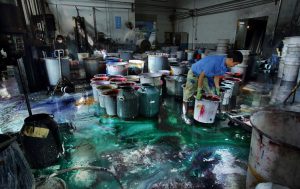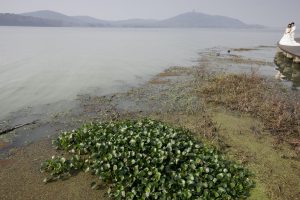Controversy has surrounded this article ever since it was first published by Southern Weekend, particularly after the family retracted their criticisms of Beijing’s tap water.
For 20 years a family headed by two water experts hasn’t drunk tap water.
The husband works for the Drinking Water Commission at the National Development and Reform Commission’s (NDRC) Public Nutrition and Development Centre. The wife, Zhao Feihong, is an official at the Healthy Drinking Water Committee under the Beijing Health Care Association.
With 40 years’ experience in the field between them, they know what they’re talking about on the topic of tap water.
“We might be the most careful household in Beijing when it comes to drinking water,” says 58-year old Zhao.
To cool down, she drinks a bottle of Kunlun Mountain mineral water. “It metabolises quickly, you always need to go to the toilet half an hour later.”
For making tea, it’s Volcano Rock from Hainan, or Quanyuan Spring from Changbaishan: “For tea you want silicic-acid rich water, soft water.” They use a local Beijing brand of mineral water for cooking – but they are sure it’s safe, as they designed the monitoring equipment for the bottling plant.
Very few of Beijing’s 20 million inhabitants are as well-informed about the secrets of tap water, purified water and mineral water as this couple.
The years of researching water quality has left them with a habit of never drinking tap water.
High nitrate levels in Beijing tap water
“Last week I tested the tap water, and levels of nitrates [measured by nitrogen content] were at over 9mg per litre,” says Zhao. That might meet the national standard of 10mg per litre, but it’s getting very close to the limit. “Five or six years ago, it was 1 to 2mg per litre, and it was only 4 and a bit as recently as 2011.”
Nitrates in drinking water come from waste, leachate and excrement – and this is only one measure of water quality. For years, Zhao has been watching the quality of Beijing’s tap water deteriorate: “There’s no dispute about it,” she says.
They’ve persuaded their friends to give up tap water too, and have become regular purchasers of mineral water at the supermarket.
In March 2007, Zhao joined a group of environmentalists on a mission to visit Beijing’s sources of water and along with thousands of other volunteers she has visited almost all of Beijing’s rivers and lakes, on one occasion walking over 30 kilometres. What she has seen has left her far from optimistic.
Most disheartening was the Miyun reservoir, over 100 kilometres to the north-west of Beijing, hidden in the Yanshan mountains, and known for its importance to the capital.
Zhao recalls a visit during the 1980s: “It was perfectly clear, you could drink from it.” At the time, it also met the Class I standard for water quality – matching German standards, known for their rigour.
When she returned with the other volunteers in 2011 the water she had once swum in still looked as clear as ever. But she knew things had changed.
In 2002, the standards for surface water were altered: what is now Class I water would only have been Class III then. In recent years, the water quality at Miyun has been Class II under those new rules. “That means it wouldn’t even meet Class III standards under the old version.”
A muddy-yellow colour of water can be seen in many of Beijing’s rivers – the Liangma, the Ba, the Macao, the Tonghui, the Liangshui, the Xiaotaihou, the Sha and the Yongding. The first large reservoir to be built after 1949, the Guanting, is so polluted its water can no longer be used for drinking – its Class IV water is held back as a reserve.
Currently water from Miyun is treated by sedimentation, filtration and disinfection before being piped to one of Beijing’s 10 main water-pumping stations. The stations also have their own groundwater wells, and the groundwater and water from Miyun are mixed and piped to ordinary homes.
Zhao admits that groundwater is cleaner than surface water, but the quality is still falling.
In the 1980s, the main source of groundwater pollution in Beijing was heavy metals, such as arsenic and lead. Things were particularly bad in Shijingshan, near the Shougang Steel plant. But today Shougang and other sources of pollution have been moved elsewhere, and organic pollutants are the main problem.
And those organic pollutants seem to be evolving. “In the 1980s, these were large molecules that you could get rid of with active carbon or ultrafiltration. But now the molecules are smaller and removal rates are very low,” says Zhao. Tap water is disinfected with chlorine, and the small organic molecules combine with the chlorine to form disinfection by-products. “And that’s what’s really scary,” she says.
But Beijing’s biggest water challenge isn’t falling water quality – it is the falling levels of groundwater.
Beijing’s watery past dries up
Three years ago Zhao helped the water company test groundwater samples. She found that samples drawn from 300 metres underground were of poorer quality than previously. If you want clean water, you have to go even deeper.
Data in the public domain show that between 1999 and 2009 the level of groundwater in the city dropped – from an average of 12 metres from the surface, to 24 metres. Currently groundwater in the city centre lies 30 metres below the surface. And an average of 500 million cubic metres of groundwater is being used every year.
“Almost all the wells around Beijing which were providing water in the 1980s are now dry,” says Zhao. Lingshui village in the outlying district of Mentougou has always been known for its water – but now all but two of its original 72 wells are dry, leaving the village short of water.
At Yufa in Daxing, the Yongding River is so reliably dried up that a sand-sculpture park has been created in the riverbed.
In 2002, the lake at Beijing’s Old Summer Palace dried up for seven months. In 2007 Kunming Lake, in the Summer Palace, dried up during the winter and spring, leaving the pleasure boats sitting on the lake bed, with floating jetties sinking into the mud. Kite enthusiasts made use of the dried-up lake, flying their kites from under the landmark Seventeen-Arch Bridge.
“Three-Wells Hutong, Two-Wells Hutong, Seven-Wells Hutong, Prince’s Mansion Well – there are over 80 hutongs [traditional Beijing alleyways] named for their wells,” says Beijing water expert Wang Jian. “Then you have place names like Sanli River, Erli Gully. They didn’t get those names without water. Think of Beijing’s place names and you’ll see how close the water used to be.”
During the Shang and Zhou Dynasties the plain on which Beijing sits was covered with rivers, lakes and marshes, and ferries were used to reach different parts of the city. In the Yuan Dynasty, there was a large expanse of water where Danleng Street in Beijing’s high-tech Zhongguancun district is now. Even as recently as the 1950s, the Yuquan hills to the west of the Summer Palace were home to rice paddies. The Emperor Qianlong wrote hundreds of poems describing the sight.
Official figures show that in just 50 years the city’s per capita water resources have dropped to less than 100 cubic metres per capita – one tenth of the global average (as recently as 2008 the Beijing Water Authority put per capita water resources at under 300 cubic metres).
Beijing today is like a thirsty octopus, with tentacles stretching out towards Hebei, Shanxi and even further to Danjiangkou to suck up water. Recycled water, karst aquifers, desalination and even taking water from the Yellow River are all under consideration by the government.
But Zhao is still worried: “Why has Beijing’s water quality dropped? Because the sources of water are too varied.”
In 2010, after a run of 11 dry years, Beijing was forced to take emergency measures and bring water in from the Cetian Reservoir in Shanxi province, and the Youyi, Huliuhe, Xiangshuibao and Yunzhou Reservoirs in Hebei.
At the time, Wang Jian visited the Cetian Reservoir and found the water was only of Class IV quality, with dead fish floating on the surface. “Beijing spent a fortune on getting that water, but it was polluted,” he says.
In a year, the city will be getting water from the South-North Water Transfer Project, and there is no doubt this will improve things massively, but Zhao is still concerned – the water will travel hundreds of miles, but will it be enough for Beijing’s growing population?
This article was originally published by Southern Weekend, January 3, 2013.


